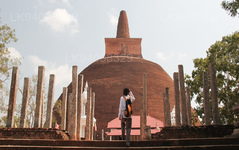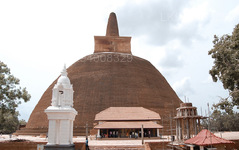
Město Anuradhapura
Anuradhapura patří do severocentrální provincie Srí Lanky. Anuradhapura je jedno ze starobylých hlavních měst Srí Lanky, známé svými dobře zachovalými ruinami starověké lanské civilizace. Město, nyní zapsané na seznamu světového dědictví UNESCO, leží 205 km severně od současného hlavního města Kolomba na Srí Lance.
Abhayagiri Dagoba
Abhayagiri Vihāra was a major monastery site of Mahayana, Theravada and Vajrayana Buddhism that was situated in Anuradhapura, Sri Lanka. It is one of the most extensive ruins in the world and one of the most sacred Buddhist pilgrimage cities in the nation. Historically it was a great monastic centre as well as a royal capital, with magnificent monasteries rising to many stories, roofed with gilt bronze or tiles of burnt clay glazed in brilliant colors. To the north of the city, encircled by great walls and containing elaborate bathing ponds, carved balustrades and moonstones, stood "Abhayagiri", one of seventeen such religious units in Anuradhapura and the largest of its five major viharas. One of the focal points of the complex is an ancient stupa, the Abhayagiri Dagaba. Surrounding the humped dagaba, Abhayagiri Vihara was a seat of the Northern Monastery, or Uttara Vihara and the original custodian of the Tooth relic in the island.
The term "Abhayagiri Vihara" refers not only to the complex of monastic buildings, but also a fraternity of Buddhist monks, or Sangha, which maintained its own historical records, traditions and way of life. Founded in the 2nd century BC, it had grown into an international institution by the 1st century AD, attracting scholars from all over the world and encompassing all shades of Buddhist philosophy. Its influence can be traced to other parts of the world, through branches established elsewhere. Thus, the Abhayagiri Vihara developed as a great institution vis‑a‑vis the Mahavihara and the Jetavana Buddhist monastic sects in the ancient Sri Lankan capital of Anuradhapura.
It is recorded in the chronicle that Abhayagiri Dagaba was established by King Valagamba during the period of his second reign, from 89-77 B.C.E. A young Brahmin named Tiya (Tissa) declared war against him. Tiya was deluded by the prophecy of another Brahmin that was destined to be king. Before the arrival of Bhikkhu Mahinda, who brought Buddhism to the island, Brahmins held the highest place in society. After the establishment of the Buddhist sangha on the island, however, they lost their supremacy, and were replaced by the sangha. Some Brahmins converted to Buddhism, while others revolted. Tiya, who enjoyed the support of his community, lived both in and outside of Sri Lanka, and was therefore very powerful.
O okrese Anuradhapura
Anuradhapura patří do severocentrální provincie na Srí Lance. Anuradhapura je jedno ze starobylých hlavních měst Srí Lanky, známé svými dobře zachovalými ruinami starověké lanské civilizace. Město, nyní zapsané na seznamu světového dědictví UNESCO, leží 205 km severně od současného hlavního města Kolomba na Srí Lance. V posvátném městě Anuradhapura a jeho okolí se nachází velké množství ruin. Ruiny se skládají ze tří tříd budov: dagoby, klášterní budovy a pokuny (rybníky). Město mělo jedny z nejsložitějších zavlažovacích systémů starověkého světa a nacházelo se v suché zóně země. Správa vybudovala mnoho nádrží k zavlažování půdy. Většina obyvatelstva jsou Sinhálci, zatímco v okrese žijí Tamilové a srílanští Maurové.
O severocentrální provincii
Severocentrální provincie, která je největší provincií v zemi, pokrývá 16 % celkové rozlohy země. Severocentrální provincie se skládá ze dvou okresů zvaných Polonnaruwa a Anuradhapure. Anuradhapura je největší okres na Srí Lance. Jeho rozloha je 7 128 km². Severocentrální provincie má pro investory mnoho potenciálu k zahájení podnikání, zejména v zemědělství, zemědělském průmyslu a chovu hospodářských zvířat. Více než 65 % obyvatel Severocentrální provincie je závislých na základním zemědělství a zemědělském průmyslu. NCP se také nazývá „Wew Bendi Rajje“, protože se v provincii nachází více než 3 000 středních a velkých nádrží. Sri maha bodiya, Ruwanweli seya, Thuparama dageba, klášter Abayagiri, Polonnaruwa Rankot wehera a Lankathilake se bojí...














